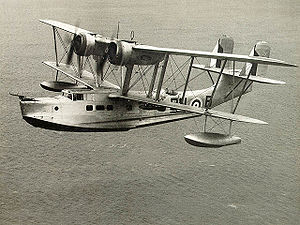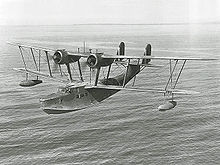Supermarine Stranraer Video - At Hendon Aircraft Museum
|
|
Supermarine Stranraer

Role: Flying boat
Manufacturer: Supermarine
Designed by: R. J. Mitchell
First flight: 24 July 1934
Introduced: 1937
Retired: 1957 (civilian use)
Primary users: RAF
RCAF
Number built: 57
Developed from: Supermarine Scapa
The Supermarine Stranraer was a 1930s British flying boat designed and built by Supermarine Aviation Works which marked the end of biplane flying-boat development for the Royal Air Force. They entered operations in 1937 and many were still in service at the outbreak of the Second World War undertaking anti-submarine and convoy escort patrols. They were withdrawn from operational service in March 1941 but continued to serve in a training capacity until October 1942.
Design and development
Designed by R. J. Mitchell as a tender to Air Ministry R.24/31 Specification for a coastal reconnaissance flying boat for the RAF, it was initially turned down but Supermarine proceeded with the type as a private venture first known as the Southampton V. A contract was placed in 1933 for a prototype powered by two 820 hp (611 kW) Bristol Pegasus IIIM and the type became known as the Stranraer.
The structure was mainly duralumin, with the hull covered with sheet metal and the wings with fabric.
Following the initial flight-test programme, the Stranraer prototype (K3973) on 24 October 1934 was delivered to the RAF. On 29 August 1935, an initial order was placed for 17 aircraft (serial numbers K7287 to K7303) to the Air Ministry Specification 17/35. The production version was fitted with the 920 hp (686 kW) Pegasus X and first flew in December 1936, entering service operations on 16 April 1937; the last Stranraer was delivered 3 April 1939. An additional order for six aircraft (K9676 to K9681) was placed in May 1936, but subsequently cancelled. A total of 40 Stranraers were built in Canada by Canadian Vickers Limited; Supermarine and Canadian Vickers being subsidiaries of Vickers-Armstrongs.
Operational history

Picture - RCAF Stranraer in wartime camouflage
In service, only 17 Stranraers were operated by the RAF 1937-1941 primarily by No. 228, No, 209, No. 240 Squadrons along with limited numbers at the No. 4 OTU. Generally, the aircraft was not well-received as its performance was considered marginal.
Due to its less than favourable reception by flight and ground crews, the Stranraer gained a large number of derisive nicknames. It was sometimes referred to as a "whistling shithouse" because the toilet opened out directly to the air and when the seat was lifted, the airflow caused the toilet to whistle. The Stranraer also acquired "Flying Meccano Set," "The Marpole Bridge," "Seymour Seine Net," "Strainer," "Flying Centre Section of the Lion's Gate Bridge" as well as a more genteel variant of its usual nickname, "Whistling Birdcage."
Royal Canadian Air Force Stranraers were exact equivalents of their RAF counterparts and while they were employed in coastal patrol against submarine threats in a similar role to the British Stranraers, no enemy action was recorded. The Canadian Vickers-built Stranraers served with the RCAF until 1946. 13 examples were sold through Crown Assets (Canadian government) and passed into civilian use after the war, several serving with Queen Charlotte Airlines (QCA) in British Columbia and operated until 1957. A re-engine project by the airline substituted 1,000 hp (746 kW) Wright GR-1820-G202GA engines in place of the original Pegasus units. In QCA use, the Stranraer gained a more suitable reputation and was "well liked" by its crews. A total of eight surplus Stranraers were also sold to Aero Transport Ltd. of Tampa, Florida.
Operators
Military
Canada
Royal Canadian Air Force
United Kingdom
Royal Air Force
No. 201 Squadron RAF
No. 209 Squadron RAF
No. 210 Squadron RAF
No. 228 Squadron RAF
No. 240 Squadron RAF
Civilian
United States
Aero Transport Ltd. (United States)
Canada
Pacific Western Airlines (Canada)
Queen Charlotte Airlines (Canada)
Specifications (Stranraer)
Data from "Database: Supermarine Stranraer."
General characteristics
Crew: 6-7
Length: 54 ft 9 in (16.7 m)
Wingspan: 85 ft 0 in (25.9 m)
Height: 21 ft 9 in (6.6 m)
Wing area: 1,457 ft² (135.4 m²)
Empty weight: 11,250 lb (5,100 kg)
Loaded weight: 19,000 lb (8,620 kg)
Powerplant: 2x— Bristol Pegasus X radial engines, 920 hp (685 kW) each
Performance
Maximum speed: 165 mph (265 km/h) at 6,000 ft (1,830 m)
Range: 1,000 mi (1,610 km)
Service ceiling: 18,500 ft (5,640 m)
Rate of climb: 1,350 ft/min (6.8 m/s)
Wing loading: 13 lb/ft² (63.7 kg/m²)
Power/mass: 0.097 hp/lb (159 W/kg)
Armament
Guns: 3 x— 0.303 in (7.7 mm) Lewis guns
Surviving aircraft
A single intact Stranraer, 920/CF-BXO, survives in the collection of the Royal Air Force Museum, London. This aircraft was built in 1940, one of 40 built by Canadian Vickers. In service with the Royal Canadian Air Force, it flew with several squadrons, on anti-submarine patrols, as a training aircraft and carrying passengers. In 1944, it was disposed of. In civil service, it was flown by Canadian Pacific Airlines until 1947, then Queen Charlotte Airlines, who replaced its original British engines with American Wright R-1820s. Queen Charlotte Airlines flew it on passenger flights until 1952, flying from Vancouver along the Pacific coast of British Columbia. It flew with several other private owners until damaged by a ship in 1966. In 1970, it was bought by the RAF Museum and transported to the UK.
The parts of a second Stranraer, 915/CF-BYJ are owned by the Shearwater Aviation Museum, Halifax, Canada. This aircraft also operated with Queen Charlotte Airlines until it crashed on Christmas Eve 1949 at Belize Inlet, British Columbia. Most of the aircraft was recovered in the 1980s, with the exception of the forward fuselage and cockpit.
Comparable aircraft
Saro London
Bibliography
Andrews, C.F. and E.B. Morgan. Supermarine Aircraft Since 1914. London: Putnam Books Ltd., 2nd revised edition 2003. ISBN 0-851-77800-3.
Bowyer, Michael J.F. Aircraft for the Few: The RAF's Fighters and Bombers in 1940. Sparkford, Nr. Yeovil, Somerset, UK: Patrick Stephens Ltd., 1991. ISBN 1-85260-040-3.
Kightly, James and Roger Wallsgrove. Supermarine Walrus & Stranraer. Sandomierz, Poland/Redbourn, UK: Mushroom Model Publications, 2004. ISBN 83-917178-9-5.
London, Peter. British Flying Boats. Stroud, Gloucestershire, UK: Sutton Publishing, 2003. ISBN 0-7509-2695-3.
Morgan, Eric. "Database: Supermarine Stranraer." Aeroplane , Volume 29, no. 4, issue 235, April 2001.
Septer, Dirk. "Canada's Stranraers." Aeroplane, Volume 29, no. 4, issue 235, April 2001.
Taylor, John W.R. "Supermarine Stranraer." Combat Aircraft of the World from 1909 to the present. New York: G.P. Putnam's Sons, 1969. ISBN 0-425-03633-2.
Thetford, Owen. British Naval Aircraft Since 1912, Fourth Edition. London: Putnam, 1978. ISBN 0-370-30021-1.
Living Warbirds: The best warbirds DVD series.
Source: WikiPedia